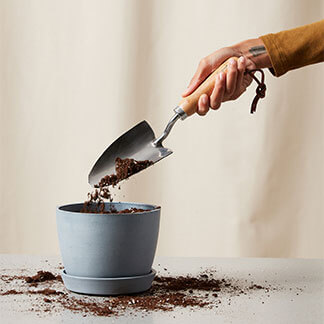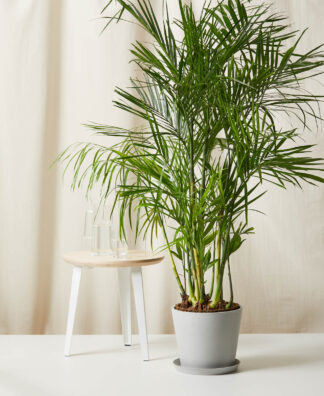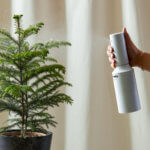How to care for your Fruit Tree
Use these instructions to care for a Fruit Tree. This guide will tell you how to water a Fruit Tree; its light, temperature, humidity preferences and any additional care it might need to help it grow.
Avocado Tree
Your avocado tree will do best in bright light. It needs 6+ hours of direct sunlight a day to thrive indoors. A south or west window will be best, but try using a grow-light if you do not think you have enough sunlight in your home.
Water when the soil is 50% dry. In the winter, it’s best to allow the soil to dry out more since the tree is not actively growing. Always test the soil before watering and water evenly until water runs through the drainage hole. Drain the excess water.
Your avocado will thrive in a humid environment. Try misting it often!
Your avocado tree will do best in warmer temperatures between 65–85°F.
For best results, use a liquid houseplant fertilizer diluted to half the recommended strength once a month during the spring and summer. Never apply fertilizer to dry soil; always make sure the soil is damp before feeding your plant.
Your avocado plant is toxic and not pet-friendly to many animals.
Trim your avocado tree back as it grows, as this will help encourage bushier growth and a stronger stem! Snip back the stems just above a leaf to remove length.
Eureka Lemon Tree
Your lemon tree prefers bright light. It will thrive receiving 12 hours of direct light a day but can do well with as little as 8 hours a day. The more light it receives, the higher chance it will produce fruit. If you are keeping your tree indoors, place it next to a South facing or West facing window, or use a grow light.
Your lemon tree prefers to be watered when 50% of the soil volume is dry. Water until liquid flows through the drainage hole at the bottom of the pot and discard any water that has accumulated in the saucer. Do not use a saucer outdoors or allow the plant to sit in standing water.
Your tree prefers a humid environment. Use a humidifier or pebble tray to increase the ambient humidity, especially during the dry winter months. Misting is not recommended with this plant since it can cause fungal issues in indoor environments that have reduced airflow.
Your tree will do best in warmer temperatures between 65–85°F. Bring indoors when the temperatures dip below 40°F at night to avoid damage from freezing temperatures.
Fertilize your tree every 3-4 months, during the growing season. Use a citrus fertilizer or a high potassium fertilizer to help your tree grow its fruit.
This tree and fruit are toxic to cats and dogs. Sap can cause skin irritation. The fruit alone is considered non-toxic to humans.
Keeping your tree properly pruned helps them grow out beautifully, prevent diseases and damage to branches, improve air circulation, and produce solid fruit. In February or March, prune back your tree’s overcrowded branches for a strong growing season. If kept outdoors, bring your lemon tree inside to winterize once the temperature falls to 40 degrees at night. During this dormant time, water sparingly and do not fertilize.
Fig Tree
Your fig tree prefers direct sunlight. Place your plant in a full sun location that receives 7+ hours of direct sunlight per day.
Water when 25-50% of the soil volume is dry. Water until liquid flows through the drainage hole at the bottom of the pot. Do not use a saucer outdoors or allow the plant to sit in standing water.
Average household humidity is fine for most areas of the US
This plant is hardy in zones 7-9. Bring indoors when the temperatures dip below 20°F. Plants can be damaged when temperatures drop below 15°F.
Feed once during the spring and once during the fall with a balanced water soluble fertilizer.
This plant is considered toxic to humans and pets if ingested. Sap can cause skin irritation. The fruit alone is considered non toxic to humans.
If keeping this plant outdoors, bring your fig tree inside to winterize once the temperature falls to 20 degrees at night. During this dormant time, water sparingly and do not fertilize. This self pollinating plant will fruit in the fall if care requirements are met. Your fig tree’s fruit will ripen on the tree. Be sure to harvest ripe fruit before they drop to avoid messy ripe fruit falling to the ground.
Olive Tree
Your olive tree prefers direct sunlight. Place your plant in a full sun location that receives 6+ hours of direct sunlight per day.
Water when 25% of the soil volume is dry. Water until liquid flows through the drainage hole at the bottom of the pot. Do not use a saucer outdoors or allow the plant to sit in standing water.
Average household humidity is fine for most areas of the US.
This plant cannot survive winter throughout most of the US. Bring indoors when the temperatures dip below 40°F. Plants can be damaged when temperatures drop below 30°F.
Feed twice a year during the spring and summer growing season with a balanced water soluble fertilizer.
Your olive tree is considered nontoxic and pet-friendly.
The olive tree needs a 2 month period of dormancy during the winter with temperatures between 40-50°F to help it produce flowers and fruit. This is also known as vernalization. Keep the plant in a bright spot indoors, water sparingly, and do not fertilize during this dormant period. This self pollinating plant can fruit in summer & fall after the third year if care requirements are met.
Orange Tree
Your orange tree prefers bright light. It will thrive receiving 12 hours of direct light a day but can do well with as little as 8 hours a day. The more light it receives, the higher chance it will produce fruit. If you are keeping your tree indoors, ensure that it gets enough exposure to light, or be sure to use a grow light.
Your orange tree prefers to be watered when 50% of the soil volume is dry. Water until liquid flows through the drainage hole at the bottom of the pot and discard any water that has accumulated in the saucer.
Your tree prefers a humid environment. Make use of a humidifier or pebble tray to increase the ambient humidity. Misting is not recommended since it can cause fungal issues in indoor environments that have reduced airflow
Your tree will do best in warmer temperatures between 65–80°F.
During the growing season starting early spring and into summer, fertilize your tree once a month. A high potassium fertilizer will help your tree grow its fruit.
The fruit and leaves of these trees are toxic to cats and dogs.
Keeping your tree properly pruned helps them grow out beautifully, prevent diseases and damage to branches, improve air circulation, and produce solid fruit. In February or March, prune back your tree’s overcrowded branches for a strong growing season.
Pink Variegated Lemon Tree
Your lemon tree prefers bright light. It will thrive receiving 12 hours of direct light a day but can do well with as little as 8 hours a day. The more light it receives, the higher chance it will produce fruit. If you are keeping your tree indoors, place it next to a South facing or West facing window, or use a grow light.
Your lemon tree prefers to be watered when 50% of the soil volume is dry. Water until liquid flows through the drainage hole at the bottom of the pot and discard any water that has accumulated in the saucer. Do not use a saucer outdoors or allow the plant to sit in standing water.
Your tree prefers a humid environment. Use a humidifier or pebble tray to increase the ambient humidity, especially during the dry winter months. Misting is not recommended with this plant since it can cause fungal issues in indoor environments that have reduced airflow.
Your tree will do best in warmer temperatures between 65–85°F. Bring indoors when the temperatures dip below 40°F at night to avoid damage from freezing temperatures.
Fertilize your tree every 3-4 months, during the growing season. Use a citrus fertilizer or a high potassium fertilizer to help your tree grow its fruit.
This tree and fruit are toxic to cats and dogs. Sap can cause skin irritation. The fruit alone is considered non-toxic to humans.
Keeping your tree properly pruned helps them grow out beautifully, prevent diseases and damage to branches, improve air circulation, and produce solid fruit. In February or March, prune back your tree’s overcrowded branches for a strong growing season. If kept outdoors, bring your lemon tree inside to winterize once the temperature falls to 40 degrees at night. During this dormant time, water sparingly and do not fertilize.



















